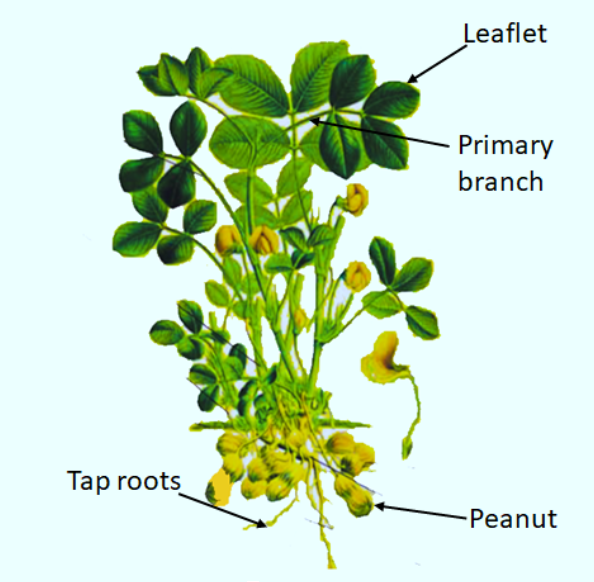
Geocarpic fruit is
(a)Potato
(b)Peanut
(c)Onion
(d)Garlic
Answer
492.9k+ views
1 likes
Hint: These plants involve the infrequent type of reproduction which produces fruits within the soil. They are widely grown in tropics and subtropics and also require less nitrogen-containing fertilizers because it can fix the atmospheric nitrogen.
Complete answer:
Peanut is a geocarpic fruit that involves the production and ripening of fruit under the surface of the soil. Peanut is taxonomically classified as Arachis hypogaea. Peanut belongs to the Fabaceae family which is classified as both legume crop and oil crop because it produces edible seeds with high oil content. It also improves the soil fertility. Geocarpic is an extremely rare type of plant reproduction in which plants produce diaspores under the soil.
Additional information:
-Geocarpy has developed as an effective method for ensuring a suitable environment for the plant's offspring.
-Geocarpy may happen in subterranean flowers or from aerial flowers where flowers penetrate the soil.
-These plants bend their stems with the purpose that fruit can be embedded in the soil during the freezing process whereas the fruit is still attached to the plant itself.
-It is most frequently found in tropical or semi-desert areas.
-Geocarpic species are found in the various families like Araceae, Brassicaceae, Begoniaceae, Callitrichaceae, Cucurbitaceae, Convolvulaceae, Leguminosae, Loganiaceae, Moraceae, and Rubiaceae.
-Geocarpy has grown as an effective means of ensuring a suitable environment for the plant's progeny.

Figure: Structure of peanut plant
So, the correct answer is ‘peanut’.
Note:
-Diaspore in plants consists of a dispersal unit that involves a seed or spore with additional tissues. This dispersal unit helps in dispersal.
-Peanuts anchorage symbiotic nitrogen-fixing bacteria found in root nodules.
Complete answer:
Peanut is a geocarpic fruit that involves the production and ripening of fruit under the surface of the soil. Peanut is taxonomically classified as Arachis hypogaea. Peanut belongs to the Fabaceae family which is classified as both legume crop and oil crop because it produces edible seeds with high oil content. It also improves the soil fertility. Geocarpic is an extremely rare type of plant reproduction in which plants produce diaspores under the soil.
Additional information:
-Geocarpy has developed as an effective method for ensuring a suitable environment for the plant's offspring.
-Geocarpy may happen in subterranean flowers or from aerial flowers where flowers penetrate the soil.
-These plants bend their stems with the purpose that fruit can be embedded in the soil during the freezing process whereas the fruit is still attached to the plant itself.
-It is most frequently found in tropical or semi-desert areas.
-Geocarpic species are found in the various families like Araceae, Brassicaceae, Begoniaceae, Callitrichaceae, Cucurbitaceae, Convolvulaceae, Leguminosae, Loganiaceae, Moraceae, and Rubiaceae.
-Geocarpy has grown as an effective means of ensuring a suitable environment for the plant's progeny.

Figure: Structure of peanut plant
So, the correct answer is ‘peanut’.
Note:
-Diaspore in plants consists of a dispersal unit that involves a seed or spore with additional tissues. This dispersal unit helps in dispersal.
-Peanuts anchorage symbiotic nitrogen-fixing bacteria found in root nodules.
Latest Vedantu courses for you
Grade 11 Science PCM | CBSE | SCHOOL | English
CBSE (2025-26)
School Full course for CBSE students
₹41,848 per year
Recently Updated Pages
Master Class 9 General Knowledge: Engaging Questions & Answers for Success

Master Class 9 English: Engaging Questions & Answers for Success

Master Class 9 Science: Engaging Questions & Answers for Success

Master Class 9 Social Science: Engaging Questions & Answers for Success

Master Class 9 Maths: Engaging Questions & Answers for Success

Class 9 Question and Answer - Your Ultimate Solutions Guide

Trending doubts
State and prove Bernoullis theorem class 11 physics CBSE

What are Quantum numbers Explain the quantum number class 11 chemistry CBSE

Who built the Grand Trunk Road AChandragupta Maurya class 11 social science CBSE

1 ton equals to A 100 kg B 1000 kg C 10 kg D 10000 class 11 physics CBSE

State the laws of reflection of light

One Metric ton is equal to kg A 10000 B 1000 C 100 class 11 physics CBSE




